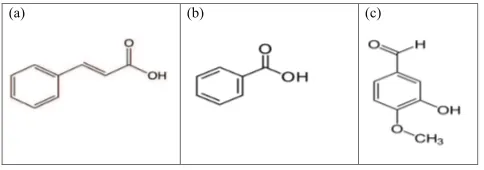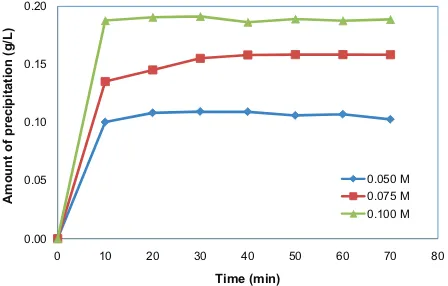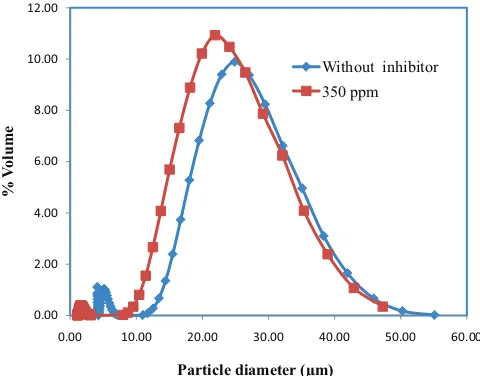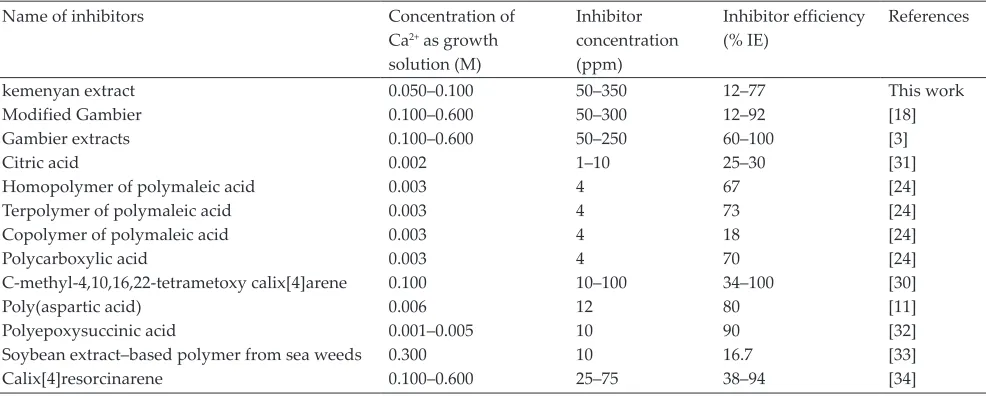* Corresponding author.
1944-3994/1944-3986 © 2017 Desalination Publications. All rights reserved.
Desalination and Water Treatment
www.deswater.com
doi: 10.5004/dwt.2017.21478
October
kemenyan (Styrax benzoin Dryand) extract as green inhibitor of calcium
carbonate (CaCO
3) crystallization
Suharso
a,*, Novi Akam Sabriani
a, Tugiyono
b, Buhani
a, Teguh Endaryanto
caDepartment of Chemistry, Faculty of Mathematics and Natural Sciences, University of Lampung, Jl. Soemantri Brojonegoro No. 1,
Bandar Lampung 35145, Indonesia, Tel. +62721704625; Fax: +62721702767; emails: suharso@fmipa.unila.ac.id, suharso_s@yahoo.com (Suharso)
bDepartment of Biology, Faculty of Mathematics and Natural Sciences, University of Lampung, Jl. Soemantri Brojonegoro No. 1,
Bandar Lampung 35145, Indonesia
cDepartment of Agricultural Economic Social, Faculty of Agriculture, University of Lampung, Jl. Soemantri Brojonegoro No. 1,
Bandar Lampung 35145, Indonesia
Received 15 March 2017; Accepted 22 September 2017
ю я Ѡ ѡ џ юѐ ѡ
To study the effect of kemenyan extract from Styrax benzoin Dryand resin as green inhibitor on calcium carbonate (CaCO3) scale formation, experiment has been carried out using a bottle roller bath method at temperature of 80°C and at various growth solutions from 0.050 to 0.100 M. The extraction result of the kemenyanwas characterized using Fourier transform infrared spectroscopy to identify functional groups found in the kemenyan extract. The morphology of CaCO3 crystal obtained was analyzed using SEM and the particle size distributions of the CaCO3 crystals produced were measured by a particle size analyzer. The result of the experiment showed that kemenyan extract can be used as a green inhib-itor of calcium carbonate scale formation. The presence of kemenyan extracts in the various growth solutions of CaCO3 0.050, 0.075, and 0.100 M gives percentage of inhibition ability from 12% to 77% in inhibiting the formation of the CaCO3 scale. The ability of the kemenyan extract to inhibit the growth rate of CaCO3 crystallization depends on amount of the inhibitor concentration added and the growth solution concentration as a crystal growth media under these experiment conditions.
Keywords: kemenyan extract; CaCO3 crystal; Green inhibitor
1. Introduction
Use of additives in inhibiting the inorganic material scale formation is used more increasingly in many industries involv-ing salt water in coolinvolv-ing system of boiler. The additives are uti-lized because of simple and economic application. Additives are able to change a crystal morphology [1], to inhibit or as inhibi-tor of crystal formation [2], or both. Therefore, negative effect of the inorganic material scale formation can be controlled earlier. Because of these negative impacts, Indonesian Oil Company (Pertamina) has spent US$ 6–7 million to renew every pipeline at the Pertamina Geothermal Power Plant every 10 years [3].
Nevertheless, the use of scale inhibitor containing compounds of sulfonate and phosphonate polymer more to inhibit the inorganic material scale formation in sev-eral industries in Indonesia such as steam power plant (PLN/ Indonesian Electricity Company) and geothermal power plant (Pertamina Geothermal Power Plant) is not envi-ronmentally friendly. The majority of industrial wastes are thrown away into aquatic environments. Of course, the use of these compounds causes environmental contamination and affects ecological equilibrium in the aquatic environments.
which are toxic and destructive for the environment as well as expensive [4–19]. For this aim, the researchers reported their inventions of development, modification, and appli-cation of the green inhibitor from various natural chemical compounds in various journals [3,8,11,12,15].
In this research, use of extract from kemenyan plant (Styrax benzoin Dryand) of Sumatra benzoin tree containing main chemical compounds such as benzoic acid, cinnamic acid, p-coumaryl cinnamate, p-coumaryl benzoate, and iso-vanillin as an inhibitor of CaCO3 scale formation was
investi-gated [20–23]. The experiments were carried out using bottle roller bath method, a crystal morphology was analyzed using scanning electron microscopy (SEM), and particle size distri-butions to study particle size diameter were performed with a particle size analyzer (PSA) [3,18].
2. Experimental procedure
2.1. Materials and instrumentation
Analytical balance (Kenr & Sohn GMBH ABT 220-4M), oven (Fisher Scientific), magnetic stirrer, bottle roller bath, glass reactor, overhead stirrer, water bath, Fourier transform infrared spectroscopy (FTIR) (Prestige–21, Shimadzu, Japan), PSA (Sedigraph III 5120, Micrometrics, USA), and SEM (JSM 6360 LA, JEOL, Japan) were used as instrument in this research.
The white kemenyan was taken from traditional market in Bandar Lampung and the chemical used in this experi-ment such as calcium chloride, acetone, sodium carbonate, ethanol, and methanol were purchased from commercial product of Merck, Germany.
2.2. Preparation of white kemenyan extract
The kemenyan (resin of Styrax benzoin Dryand from Sumatra benzoin tree) is graded based on the size of pieces. kemenyan farmers or sellers classify it into four different lev-els in the trade, from 1 (very large pieces and without for-eign particle) to 4 (very small size and close to powder). In this research, it was selected the fresh white kemenyan with grade of 1 purchased directly from seller in Bandar Lampung City, Sumatera, Indonesia. To obtain the kemenyan extract as scaling inhibitor, the white kemenyan of grade 1 was pounded into powder. 50 g of powdered white kemenyan was heated in water with total volume of 1 L at a temperature of 50°C for 1 h and it was kept for 1 night. Then, it was filtered and the filtrate was identified by FTIR to investigate the func-tional groups playing a role from some chemical compounds such as benzoic acid, cinnamic acid, p-coumaryl cinnamate, p-coumaryl benzoate, and isovanillin in the kemenyan extract as reported by previous researchers [20]. The extract was used as the inhibitor in this research.
2.3. Crystallization experiments
The growth solution of CaCO3 0.050 M was prepared
with mixing 200 mL of 0.100 M CaCl2 anhydrate solution and 200 mL of Na2CO3 0.100 M in 500 mL of Nalgene polypropyl-ene bottle at temperature of 80°C. The mixture was stirred by magnetic stirrer up to homogeneous solution and filtered by 0.45 μm Millipore filter. The growth solution was placed into
250 mL Nalgene polypropylene bottle each of 50 mL for seven bottles. These bottles were left in the bottle roller bath at tem-perature of 80°C. The bottle roller bath was used to rotate bot-tles containing the growth solution of CaCO3 crystals and seed
crystal of CaCO3 with or without inhibitor to study the effect
of inhibitor on the growth rate of the CaCO3 crystal at the spe-cific temperature and rotation. The bottle roller was adjusted to rotate at 40 revolutions/min. Over the 70 min experiment, a bottle was taken every 10 min. The precipitate was washed thoroughly with deionized water and dried at a temperature of 105°C in the oven for 1 d. The weight of the crystals was measured and the amount precipitated was calculated as data of precipitation mass change to count the growth rate of CaCO3 precipitation. The experiments were repeated for
dif-ferent growth concentrations of 0.075 and 0.100 M with the same treatment like previous experiment of 0.050 M.
2.4. Experiment of kemenyan extract as inhibitor
The experiment to study the influence of inhibitor addi-tion was performed by adding the kemenyan extract of vari-ous concentrations 0, 50, 150, 250, and 350 ppm in the growth solution of 0.050, 0.075, and 0.100 M. The procedure applied was similar with the procedure done in the crystallization experiment without kemenyan extract addition. The precip-itation mass obtained was analyzed to investigate the effect of the kemenyan extract addition on the CaCO3 scale forma-tion. Inhibitor effectiveness (%) could be measured based on Eq. (1) [24]:
ȱěȱǻƖǼȱƽȱŗŖŖȱƼȱǿǻCx–Cy)/(Cz–Cy)} (1)
where Cxȱ ƽȱ 3 concentration with inhibitor at
equilibrium (g/L); Cyȱƽȱ3 concentration without inhibitor at equilibrium (g/L); Czƽȱȱ3 concentration (g/L).
2.5. Data analysis
Acquired data of precipitation amount vs. time at various concentrations of growth solution and the addition of kemen-yan extract additive were analyzed by MS Excel 2007. The effectiveness of kemenyan extract in hindering the CaCO3
scale formation was determined by the amount of precipita-tion obtained and particle size distribuprecipita-tion of CaCO3 crystal. The particle size distributions of CaCO3 crystal were identi-fied by PSA and the morphology of crystal was analyzed by SEM.
3. Results and discussion
of carboxylate from cinnamic and benzoic acid. The exis-tence of weak absorption at 2,800 1/cm gives indication of C–H aldehyde functional group from isovanillin and the absorption at 1,689.64 1/cm with sharp and strong intensity
ȱȱ¡ȱȱ¢ȱȱǻƽǼǯȱȱȱ ȱȮƽȮȱȱȱȱȱȱȱ ȱ
the absorption band at around 1,512.19–1,450.47 1/cm with sharp and strong intensity and strengthened in the area of 3,000 1/cm. These functional groups are matched to main compounds of kemenyan extract which are soluble in water especially cinnamic acid, benzoic acid, and isovanillin (Fig. 2).
3.2. Experiment of kemenyan inhibitor
Observation result data of the CaCO3 crystal growth rate at different concentrations can be seen in Table 1, while the data of the CaCO3 crystal growth rate at different growth
solution concentration and different inhibitor concentrations are displayed in Tables 2–4. In Table 1, it can be observed that as the growth solution concentration increases, the amount of crystal precipitation will also raise. This fact shows that the growth rate of the CaCO3 crystal is bigger with the increasing
of the growth solution concentration (Fig. 3).
Fig. 1. IR spectrum of kemenyan extract.
(a) (b) (c)
Fig. 2. Chemical structure of (a) cinnamic acid, (b) benzoic acid, and (c) isovanillin.
Table 1
Growth rate of CaCO3 precipitation with various concentrations
Time (min) Amount of precipitation (g/L)
0.050 M 0.075 M 0.100 M
Effect of kemenyan extract addition on CaCO3 scale formation at growth solution concentration of 0.050 M
Time (min)
Amount of precipitation (g/L)
0 ppm 50 ppm 150 ppm 250 ppm 350 ppm
Effect of kemenyan extract addition on CaCO3 scale formation at growth solution concentration of 0.075 M
Time (min)
Amount of precipitation (g/L)
0 ppm 50 ppm 150 ppm 250 ppm 350 ppm
Effect of kemenyan extract addition on CaCO3 scale formation at growth solution concentration of 0.100 M
Time (min)
Amount of precipitation (g/L)
Effects of the kemenyan extract addition at various con-centrations of 0–350 ppm on the CaCO3 crystal precipitation at the various growth solution concentrations of 0.050, 0.075, and 0.100 M in the absence of seed crystal can be observed in Figs. 4–6. From Figs. 4–6, generally it can be stated that the higher the concentration of the kemenyan extract added the bigger the ability of inhibition of the CaCO3 scale formation. In the presence of 350 ppm of the kemenyan extract in the growth solution of CaCO3 0.050 M, inhibition of the growth
rate of the CaCO3 scale formation is significantly around 76.92% (Table 5). These facts also occur at the concentration of 0.075 and 0.100 M each of 49.62% and 46.19% in the pres-ence of the kemenyan extract inhibitor from 250 and 350 ppm (Tables 6 and 7). This result is also compared with the exper-iment of copolymer modified with the palygorskite as inhib-itor for calcium carbonate scale [25].
In order to prove deeply the effect of inhibitor addition (kemenyan extract) on the CaCO3 crystal growth, it is
investi-gated the growth of CaCO3 crystal with using SEM (Figs. 7–9). From these observations with using SEM, the addition of the inhibitor in the growth solution of CaCO3, the kemenyan
extract can reduce the growth rates of the CaCO3 crystals.
These evidences can be seen in Figs. 7–9, the addition of the kemenyan extract made morphology size of the CaCO3 crys-tals smaller than without the addition of the kemenyan extract. The next evidence to investigate the effect of the kemen-yan extract in hindering the growth rate of CaCO3 crystal is with analyzing the particle size distribution of the CaCO3 crystals obtained using PSA. Analysis of these particle size distributions was performed upon the CaCO3 crystal
forma-tion in the absence of inhibitor and compared with in the pres-ence of inhibitor. Analysis results are displayed in Figs. 10 and 11. Analysis result of particle size distributions shows that the addition of the kemenyan extract generally inhibits the growth rates of the CaCO3 crystals. In the presence of 350 ppm of the
kemenyan extract in the growth solution of CaCO3 crystal 0.100 M can reduce the averages of the CaCO3 crystal particle sizes from 12.72 to 9.70 μm (Fig. 10). Furthermore, the addi-tion of the kemenyan extract 350 ppm in 0.075 M growth solu-tion of CaCO3 is able to decrease the averages of CaCO3 crystal particle sizes distribution from 10.47 to 8.03 μm (Fig. 11). From the series of the experiments performed, in general, kemen-yan extract plays a role as inhibitor in inhibiting the growth rate of the CaCO3 scale formation and it can be compared with
0.00
Amount of precipitation (g/L
)
Time (min)
0.050 M
0.075 M
0.100 M
Fig. 3. Growth rate of CaCO3 crystal at various growth solution concentrations.
Amount of precipitation (g/L
)
Fig. 4. Effect of kemenyan extract addition on CaCO3 precipitation at growth solution concentrations of 0.050 M.
0.00
Amount of precipitation (g/L
)
Fig. 5. Effect of kemenyan extract addition on CaCO3 precipitation at growth solution concentrations of 0.075 M.
0.00
Amount of precipitation (g/L
)
Fig. 6. Effect of kemenyan extract addition on CaCO3 precipitation at growth solution concentrations of 0.100 M.
Table 5
Effectiveness of kemenyan extract in inhibiting growth rate of CaCO3 scale at growth solution concentration of 0.050 M
another scale inhibitor like Gambier extract [3], copolymer modified with palygorskite [25], acrylic acid–allylpolyethoxy carboxylate [26], a novel fluorescent-tagged scale inhibitor [27], and water-soluble anhydride containing alternating copolymers [28].
The scale process of microsolubility salts like CaCO3 in cooling water system is just the process of crystallization; calcium carbonate scale formation consists of two steps: nucleation and growth [27]. Thus the mechanism of inhibi-tion in this experiment is inhibitor containing carboxyl group adsorb on the scale surface causing inhibition of scale nuclei formation. The more kemenyan extract added in the growth solution, the more the carboxyl group existing in kemenyan extract will react to Ca2+ ion to inhibit the formation of CaCO
3
nuclei. In this case, it will occur that nucleation step of the CaCO3 will be hardly formed in the experiment solution. This can identified with investigating the morphology of CaCO3 crystal in the absence and in the presence of inhibitor
(Figs. 8 and 9). The morphology of the CaCO3 crystal in the presence of inhibitor changes to be smaller in size proving the inhibitor playing a role. This result is consistent with the result obtained from the previous experiment [26,29,30].
Table 6
Effectiveness of kemenyan extract in inhibiting growth rate of CaCO3 scale at growth solution concentration of 0.075 M
Inhibitor concentration (ppm) Inhibitor efficiency (%) 0
50 150 250 350
0.00 24.37 23.42 49.62 43.62
Table 7
Effectiveness of kemenyan extract in inhibiting growth rate of CaCO3 scale at growth solution concentration of 0.100 M
Inhibitor concentration (ppm) Inhibitor efficiency (%) 0
50 150 250 350
0.00 11.71 21.13 31.30 46.19
a
b
Fig. 7. Morphology of CaCO3 crystal at growth solution concentration of 0.050 M (a) without and (b) with the addition of inhibitor 350 ppm.
a b
The inhibitor effectiveness is affected by the concentra-tion of Ca2+ ion in the growth solution; usually the higher the
concentration of Ca2+ ion in the growth solution, the higher
the inhibitor needed to inhibit the formation of the CaCO3 crystal. Table 8 shows the comparison of inhibitor efficiency from several researchers. The inhibitor of citric acid with the concentration of Ca2+ ion in the growth solution 0.0019 M
needed 1–10 ppm to inhibit the formation of the CaCO3 with
the inhibitor efficiency of 25%–30% [31]. While, the polyep-oxysuccinic acid with the concentration of Ca2+ ion in the
growth solution from 0.001 to 0.005 M involved 10 ppm of this inhibitor to gain the inhibitor efficiency of 90% [32]. The results of these experiments obtained the inhibitor efficiency of 12%–77% with the concentration of Ca2+ ion from 0.05 to
0.10 M and inhibitor added of 50–350 ppm. If these results are compared with the previous researches as listed in Table 8, these results are still reasonable.
4. Conclusions
The extract of the kemenyan resin can be used as a green inhibitor of the CaCO3 scale formation. The addition of the kemenyan extract in the various growth solutions of the CaCO3 0.050, 0.075, and 0.100 M was able to inhibit signifi-cantly the growth rates of the CaCO3 precipitation with the
percentage of inhibition ability from 12% to 77%. The inhi-bition ability depends on the inhibitor concentration added and growth solution concentration as crystal growth media under these condition experiments.
Acknowledgements
This project was supported by the Directorate of Research and Community Services, Directorate General of Higher Education (DIKTI), Ministry of Research, Technology and Higher Education of the Republic of Indonesia from the Competency Research Grant/Hibah Berbasis Kompetensi, with contract number: 050/SP2H/PL/Dit.Litabmas/II/2015 and 80/UN26/8/LPPM/2016, 13 April 2016.
a
b
Fig. 9. Morphology of CaCO3 crystal at growth solution concentration of 0.100 M (a) without and (b) with the addition of inhibitor 350 ppm.
0.00 2.00 4.00 6.00 8.00 10.00 12.00
0.00 10.00 20.00 30.00 40.00 50.00 60.00
%
Vo
lume
Particle diameter (µm)
Without inhibitor
350 ppm
Fig. 10. Particle size distribution of CaCO3 crystals without and with the addition of 350 ppm kemenyan extract at growth solution concentration of 0.100 M.
0.00 2.00 4.00 6.00 8.00 10.00 12.00
0.00 10.00 20.00 30.00 40.00 50.00 60.00
%
Vo
lume
Par!cle diameter (µm)
Without inhibitor 350 ppm
References
[1] Suharso, G. Parkinson, M. Ogden, Effect of cetyltrimethylammonium bromide (CTAB) on the growth rate and morphology of borax crystals, J. Appl. Sci., 7 (2007) 1390–1396.
[2] Suharso, Buhani, L. Aprilia, Influence of calix[4]arene derived compound on calcium sulphate scale formation, Asian J. Chem., 26 (2014) 6155–6158.
[3] Suharso, Buhani, S. Bahri, T. Endaryanto, Gambier extracts as an inhibitor of calcium carbonate (CaCO3) scale formation, Desalination, 265 (2011) 102–106.
[4] R.C. Xiong, Q. Zhou, G. Wei, Corrosion inhibition of a green scale inhibitor polyepoxysuccinic acid, Chin. Chem. Lett., 14 (2003) 955–957.
[5] N.P. Tung, N.T.P. Phong, N.H. Duy, N.T. Hieu, Design of the High Effective Green Scale Inhibitor Stable in Harsh Reservoir Conditions, Proc. 8th German-Vietnamese Seminar on Physics and Engineering, Erlangen, 2005.
[6] A.O. Saleah, A.H. Basta, Evaluation of some organic-based biopolymers as green inhibitors for calcium sulfate scales, Environmentalist, 28 (2008) 421–428.
[7] Q.Z. Hua, C.Y. Chang, W.X. Rong, S. Cheng, L.Y. Jie, M.C. Fang, Experimental study on scale inhibition performance of a green scale inhibitor polyaspartic acid, Sci. China Ser. B Chem., 51 (2008) 695–699.
[8] A. Martinod, M. Euvrard, A. Foissy, A. Neville, Progressing the understanding of chemical inhibition of mineral scale by green inhibitors, Desalination, 220 (2008) 345–352.
[9] D. Hasson, H. Shemer, A. Sher, 2011, State of the art of friendly “Green” scale control inhibitor: a review article, Ind. Eng. Chem. Res., 53 (2011) 64–69.
[10] D. Zeng, W. Qin, Study on a novel composite eco-friendly corrosion and scale inhibitor for steel surface in simulated cooling water, J. Surf. Eng. Mater. Adv. Technol., 2 (2012) 137–141.
[11] D. Liu, W. Dong, F. Li, F. Hui, J. Ledion, Comparative performance of polyepoxysuccinic acid and polyaspartic acid on scaling inhibition by static and rapid controlled precipitation methods, Desalination, 304 (2012) 1–10.
[12] A.M. Abdel-Gaber, B.A. Nabey, E. Khamis, H. Abd-El-Rhmann, H. Aglan, A. Ludwick, Green anti-scalent for cooling water systems, Int. J. Electrochem. Sci., 7 (2012) 11930–11940. [13] D. Zeng, H. Yan, Study on an eco-friendly corrosion and scale
inhibitor in simulated cooling water, Am. J. Eng. Res., 2 (2013) 39–43.
[14] D. Zeng, H. Yan, Experimental study on a new corrosion and scale inhibitor, J. Environ. Prot., 4 (2013) 671–675.
[15] E. Antonogiannakis, E. Tzagkaraki, K.D. Demadis, Use of a pilot scale heat exchanger-cooling tower system for the evaluation of mineral scale inhibitors, Int. J. Corros. Scale Inhib., 2 (2013) 255–268.
[16] G. Jing, X. Li, Dynamic laboratory research on synergistic scale inhibition effect of composite scale inhibitor and efficient electromagnetic anti-scaling instrument, Res. J. Appl. Sci. Eng. Technol., 6 (2013) 3372–3377.
[17] B.P.H. Do, B.D. Nguyen, H.D. Nguyen, P.T. Nguyen, Synthesis of magnetic composite nanoparticles enveloped in copolymers specified for scale inhibition application, Adv. Nat. Sci. Nanosci. Nanotechnol., 4 (2013) 045016.
ǽŗŞǾȱ ǰȱ ǯȱ ǰȱ ǯȱ ¢ǰȱ ǰȱ ęȱ ȱ Gambier extracs as green inhibitor of calcium carbonate (CaCO3) scale formation, J. Water Process Eng., 18 (2017) 1–6. [19] M. Chaussemier, E. Pourmohtasham, D. Gelus, N. Pécoul, H.
Perrot, J. Lédion, H. Cheap-Charpentier, O. Horner, State of art of natural inhibitors of calcium carbonate scaling. A review article, Desalination, 356 (2015) 47–55.
[20] M. Hovaneissian, P. Archier, C. Mathe, G. Culioli, C. Vieillescazes, Analytical investigation of styrax and benzoin balsams by HPLC-PAD-fluorimetry and GC-MS, Phytochem. Anal., 19 (2008) 301–310.
[21] X. Fernandez, C. Castel, L. Lizzani-Cuvelier, C. Delbecque, S.P. Venzal, Volatile constituents of benzoin gums: Siam and Sumatra, part 3. Fast characterization with an electronic nose, Flavour Fragrance J., 21 (2006) 439–446.
[22] C. Castel, X. Fernandez, L. Lizzani-Cuvelier, A.-M. Loiseau, C. Perichet, C. Delbecque, J.-F. Arnaudo, Volatile constituents of benzoin gums: Siam and Sumatra, part 2. Study of headspace sampling methods, Flavour Fragrance J., 21 (2006) 59–67. [23] X. Fernandez, L. Lizzani-Cuvelier, A.-M. Loiseau, C. Périchet,
C. Delbecque, Volatile constituents of benzoin gums: Siam and Sumatra. Part 1, Flavour Fragrance J., 18 (2003) 328–333. [24] S. Patel, M.A. Finan, New antifoulants for deposit control in
MSF and MED plants, Desalination, 124 (1999) 63–74.
[25] X. Guo, F. Qiu, K. Dong, X. Rong, K. He, J. Xu, D. Yang, Preparation and application of copolymer modified with the palygorskite as inhibitor for calcium carbonate scale, Appl. Clay. Sci., 99 (2014) 187–193.
[26] J. Huang, G. Liu, Y. Zhoua, Q. Yao, L. Linga, P. Zhang, H. Wang, K. Cao, Y. Liu, W. Wu, W. Sun, Synthesis and application of an environmentally friendly antiscalant in industrial cooling systems, J. Water Chem. Technol., 36 (2014) 166–173.
Table 8
Comparison of inhibitor efficiency in inhibiting CaCO3 formation from several researchers
Name of inhibitors Concentration of
Ca2+ as growth
Homopolymer of polymaleic acid Terpolymer of polymaleic acid Copolymer of polymaleic acid Polycarboxylic acid
C-methyl-4,10,16,22-tetrametoxy calix[4]arene Poly(aspartic acid)
Polyepoxysuccinic acid
[27] H. Wang, Y. Zhou, Q. Yao, S. Ma, W. Wu, W. Sun, Synthesis of fluorescent-tagged scale inhibitor and evaluation of its calcium carbonate precipitation performance, Desalination, 340 (2014) 1–10.
[28] H.K. Can, G. Üner, Water-soluble anhydride containing alternating copolymers as scale inhibitors, Desalination, 355 (2015) 225–232.
[29] K. Cao, J. Huang, Y. Zhou, G. Liu, H. Wang, Q. Yao, Y. Liu, W. Sun, W. Wu, A multicarboxyl antiscalant for calcium phosphate and calcium carbonate deposits in cooling water systems, Desal. Wat. Treat., 52 (2014) 7258–7264.
[30] Suharso, Buhani, T. Suhartati, The role of C-methyl-4,10,16,22-tetrametoxy calix[4]arene as inhibitor of calcium carbonate (CaCO3) scale formation, Indo. J. Chem., 9 (2009) 206–210.
[31] M.M. Reddy, A.R. Hoch, Calcite crystal growth rate inhibition by polycarboxylic acids, J. Colloid Interface Sci., 235 (2001) 365–370.
[32] Y. Sun, W. Xiang, Y. Wang, Study on polyepoxy succinic acid reverse osmosis scale inhibitor, J. Environ. Sci., 21 (2009) S73–S75.
[33] B.A. Miksic, M.A. Kharshan, A.Y. Furman, Vapor Corrosion and Scale Inhibitors Formulated from Biodegradable and Renewable Raw Materials, European Symposium on Corrosion Inhibitors (10 SEIC), Ferrara, Italy, 2005.




